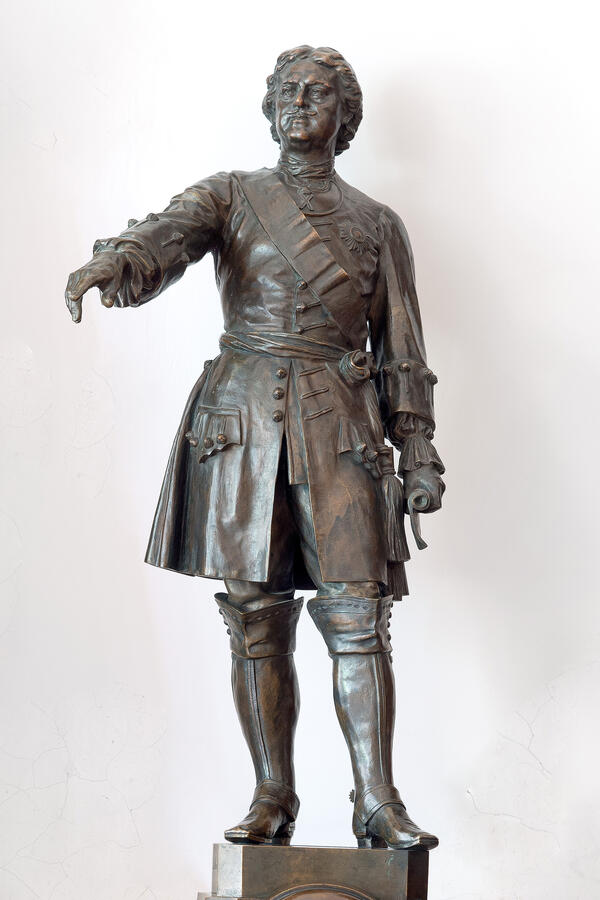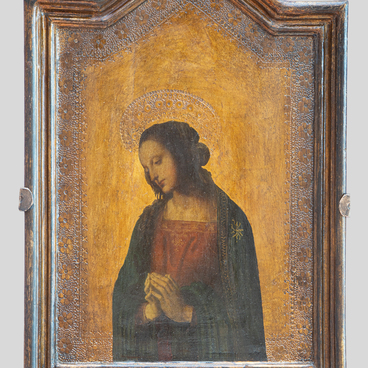The model reproduces the monument to Emperor Peter the Great, erected in the city of Petrozavodsk. Peter the Great visited Petrovskaya Sloboda (Petrozavodsk) on many occasions. He came to inspect the manufacturing processes at the Peter the Great Weapons Factory and to be treated at the first Russian health resort “Marcial Waters”. Especially for the tsar a wooden two-storied traveling palace was built which was surrounded by a garden similar to the Summer Garden in St. Petersburg. After the tsar died, however, the palace and the park fell into disrepair, and in 1773 the dilapidated palace was dismantled.
The idea to erect a monument to Tsar the Reformer at the site of the Tsar’s ruined travel palace first occurred to Olonets governor Nikolai Everestovich Pisarev in 1850. But it was only 20 years later, in 1870, that they started to make the model and cast the monument. The sculptor Ivan Schroeder and the architect Ippolit Monighetti were the designers of the project. The work was carried out at the artistic bronze casting and electroplating factory of Adolphe Morand in St. Petersburg.
An interesting fact is that a plaster model of the monument was displayed for public viewing in the governor’s house. The ceremonial laying of the foundation stone took place on May 30, 1872, on Petrovskaya Square (now Lenin Square) in the presence of the governor, clergy, army units, representatives of the city Duma (council) and the zemstvo (local government).
Peter I is depicted full-length, in full dress uniform, with a ribbon and star of the Order of St. Andrew. His right hand is pointing in the direction of the mouth of the Lososinka River, where he ordered the construction of an iron-smelting and cannon foundry. His left hand is holding a half-opened scroll, symbolizing the reform guidelines. The monument’s overall height is 6 m 30 cm, the height of the emperor’s figure is 2 m 90 cm. The pedestal of the monument is carved from Sortavala gray granite by a rock carver Barinov, as designed by Ippolito Monighetti.
The model of the monument to Peter the Great is in its original place — in the Library of the Alexander Palace.
The idea to erect a monument to Tsar the Reformer at the site of the Tsar’s ruined travel palace first occurred to Olonets governor Nikolai Everestovich Pisarev in 1850. But it was only 20 years later, in 1870, that they started to make the model and cast the monument. The sculptor Ivan Schroeder and the architect Ippolit Monighetti were the designers of the project. The work was carried out at the artistic bronze casting and electroplating factory of Adolphe Morand in St. Petersburg.
An interesting fact is that a plaster model of the monument was displayed for public viewing in the governor’s house. The ceremonial laying of the foundation stone took place on May 30, 1872, on Petrovskaya Square (now Lenin Square) in the presence of the governor, clergy, army units, representatives of the city Duma (council) and the zemstvo (local government).
Peter I is depicted full-length, in full dress uniform, with a ribbon and star of the Order of St. Andrew. His right hand is pointing in the direction of the mouth of the Lososinka River, where he ordered the construction of an iron-smelting and cannon foundry. His left hand is holding a half-opened scroll, symbolizing the reform guidelines. The monument’s overall height is 6 m 30 cm, the height of the emperor’s figure is 2 m 90 cm. The pedestal of the monument is carved from Sortavala gray granite by a rock carver Barinov, as designed by Ippolito Monighetti.
The model of the monument to Peter the Great is in its original place — in the Library of the Alexander Palace.






